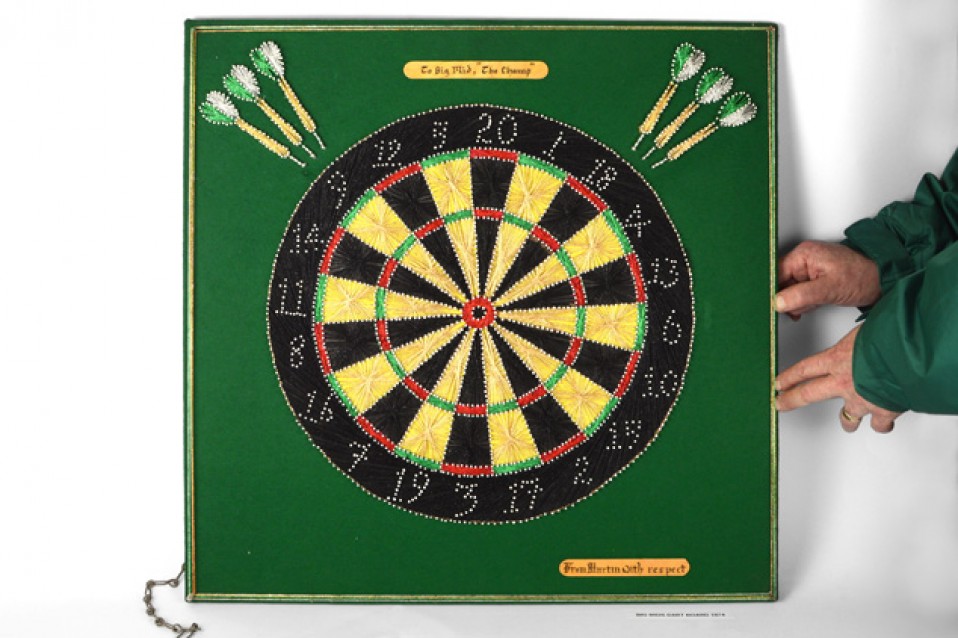
Opening
Thursday, 13 September 2018, 6-8pm
Opening hours
Tues- Fri, 1-5pm, Sat 12-4pm (21 September: Culture Night, 1-10pm + Late Night Art)
Dispersed-Presence
The Material Culture of Long Kesh/Maze
Martin Krenn (Vienna), Aisling O’Beirn (Belfast),
Ends 06 October 2018
The exhibition ‘Dispersed Presence 'The Material Culture of Long Kesh/Maze’ by
Martin Krenn and Aisling O’Beirn is based on a collaborative social
sculpture by these artists, exploring the future of the Long Kesh/Maze
former prison site beyond its current state of limbo. In thinking of
the former prison as a dispersed presence the artists focus
particularly on archaeologist Laura McAtackney’s concept of the
‘distributed self’ from her key text on the prison, ‘An Archaeology
of the Troubles’, (McAtackney, 2014: 244-265) This former prison,
where most republican and loyalist prisoners were incarcerated as a
result of the conflict in Northern Ireland has both a physical presence
as well as a conceptual importance. Indecision about the future of
this partially demolished site at government level says much about the
political climate of a post-conflict society. Given this, the artists
are interested in how one can think beyond the site’s legacy and to
its future.
Ongoing dialogue with McAtackney during the course of the
research also provided invaluable contacts with many people who had 1st
hand experience of the prison allowing the artists to develop their
approach. The artists then worked with a range of participants with 1st
hand experience of the prison, to collaboratively photograph existing
prison artefacts or to co-create unique small sculptural objects to
reflect their personal experiences of this site. Many of the featured
artefacts and objects have not been seen before as they are in private
hands. Each photograph of the objects is accompanied by a testimony
from their maker or custodian. Techniques for creating the new objects
include methods traditionally used in making prison art. Some of them
were crafted together with the 50+ Group, a group of women who
regularly visited Long Kesh. The resultant photo text artworks and
newly created objects form the basis for this exhibition. The artists
also produced an ongoing touring exhibition of a set of 64 postcards
aimed at public and community venues.
The artists believe that a multi-perspective discussion, based on
human experiences, rather than reiterations of already established
narratives, would serve to productively address the sites’ difficult
past and uncertain future. The aim of their project is to engage in
transformative discourse that hopefully contributes to the ongoing peace
process in Northern Irish post-conflict society.
Friday, 14 September, 5pm: In conversation- free event with project artists Martin Krenn and Aisling O’Beirn, curator Suzana Milevska and Peter Mutschler.
This ‘in conversation’ led by art theorist and curator Suzana Milevska and PS² organiser Peter Mutschler will take place with artists Martin Krenn and Aisling O’Beirn. They will discuss dialogical art practices in relation to the Dispersed Presences exhibition by Krenn and O’Beirn with opportunities for questions from the audience. This is a free event all welcome.
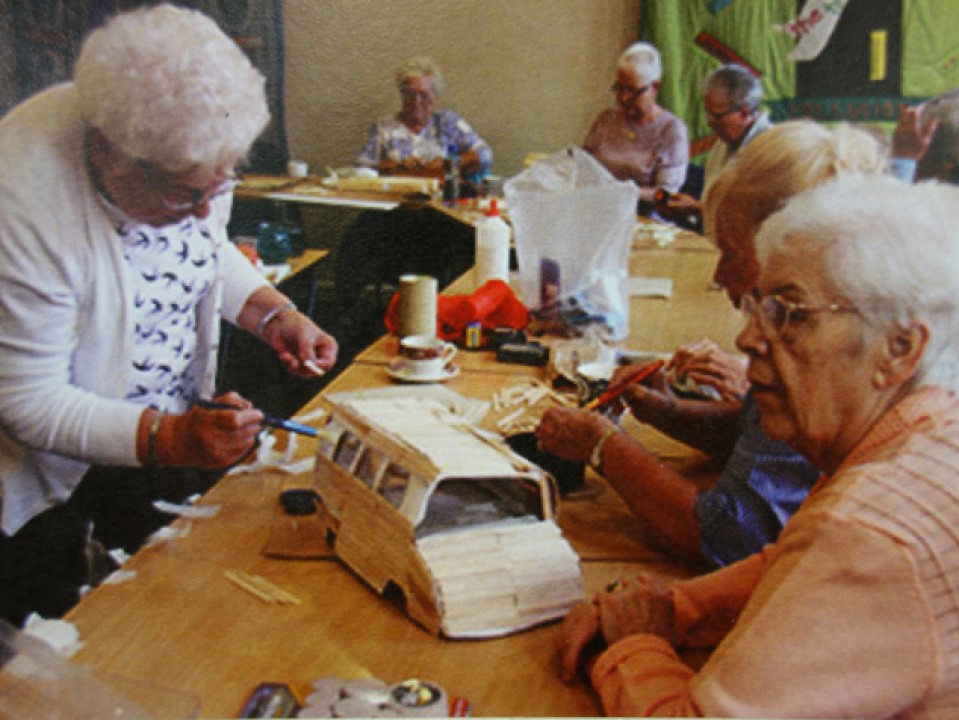
Workshop
Martin Krenn and Aisling O’Beirn
are artists who have worked in the field of socially engaged art for
more than 15 years. O’ Beirn is based in Belfast and teaches at Ulster
University, Krenn is living in Vienna and teaching at the University of
Applied Arts Vienna. Their work is being supported by the archaeologist
Laura McAtackney.
Suzana Milevska is a visual culture theorist and curator. Her theoretical and curatorial interests include postcolonial critiques of the hegemonic power regimes of representation, gender theory and feminism, participatory, collaborative and research-based art practices. Currently she is principal investigator at the Politecnico di Milano (TRACES, Horizon 2020). From 2013 to 2015 she was the endowed professor for Central and South European Art Histories at the Academy of Fine Arts in Vienna and taught at the Visual Culture Unit at the Technological University in Vienna. Milevska was Fulbright Senior Research Scholar (2004) and received a PhD in Visual Cultures from Goldsmiths College - University of London (2006). In 2012, she won the Igor Zabel Award for Culture and Theory.
Peter Mutschler is an artist,
(non)curator and director of PS², Belfast, an artist-run project space
and studios. His interest is in art and cultural production, which is
socially relevant, experimental, unconventional, risk-taking and
artistically brilliant.
He tries to link society and art through work and processes that
connect with people’s everyday lives, be it inside the art space or at
outside locations. He stubbornly continues to work on two long-term
projects with artists and communities in the small village and former
British Army site of Ballykinler, and PeasPark at an interface area in
North Belfast.
Peter Mutschler, PS², Belfast www.pssquared.org
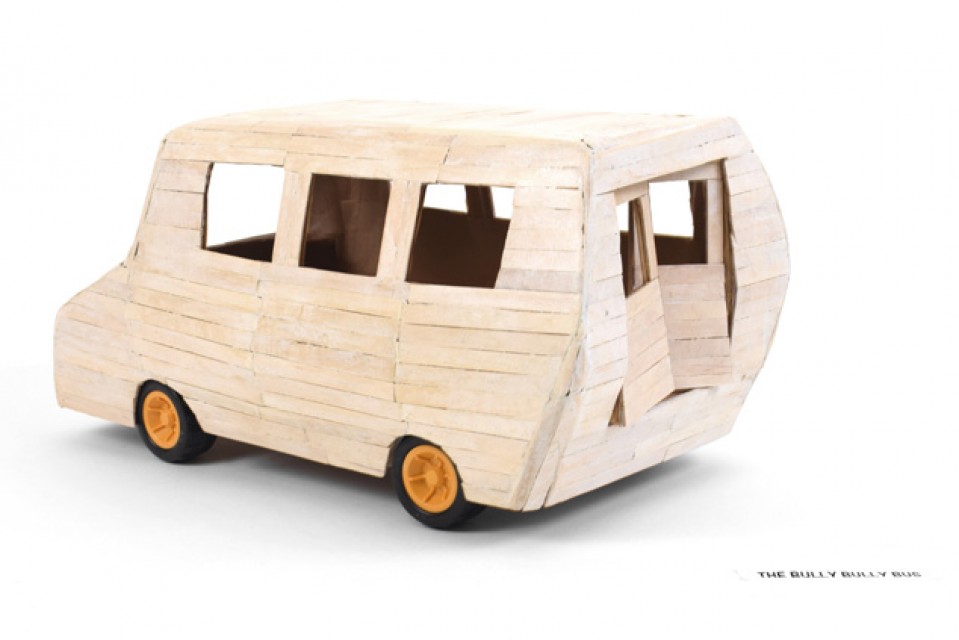
Krenn & O’Beirn and the 50+Group, The Bully Bully Bus, 2018 Materials: Card, glue lollypop sticks, paper tape, wood & varnish Dimensions: 50 cm x 30 cm 30cm Testimony courtesy of the 50+ Group. Artefact made by the 50 + group with Krenn and O’ Beirn A resident of Hamill St. drove the bus.* It was called the Bully Bully Bus because the first time Maureen and I went on it to go for a visit to jail, all the young women on it with their babies and young children were singing rebel songs. We couldn’t sing because we were crying so much. It was miserable. The women were amazing because some of them were very young but they kept their spirits up by singing. * Local people volunteered to drive relatives to the prison once a week for prison visits. Many of the women in the 50 + group got to know each other going on these gruelling weekly prison visits. This system of someone volunteering to drive relatives to their visits was also used in loyalist areas. We photographed a table made as a thank you to someone who drove a bus for relatives of loyalist prisoners.
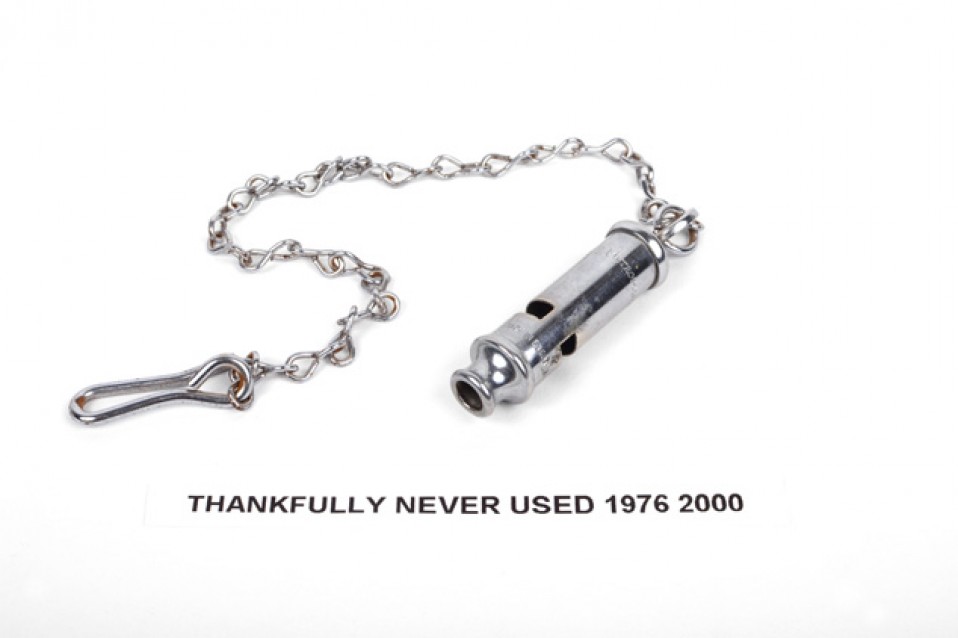
Krenn & O’Beirn, Thankfully Never Used 1976 2000, 2018 Photographic print of artefact Description: Stainless steel whistle on a chain with buttonhole clasp. Made in England embossed on whistle barrel.Artefact dimensions: 50 cm x 5 cm 5cm Testimony and artefact courtesy of Phil Holland, former prison officer The only thing that I kept of my own, that I thought worthy of keeping, was my prison service issue alert whistle. I don’t know why I kept it, but it’s just been there. I’ve had that from when I first joined in 1976. It was something that was part of my uniform. It was like an adornment between the two breast pockets. You would have used it if needed if you’d had time to do so. If there were any trouble you knew to call for help because a lot of the time in the prison you were on your own. You could have been quite isolated at times. You used to only hope that you never needed to use it.
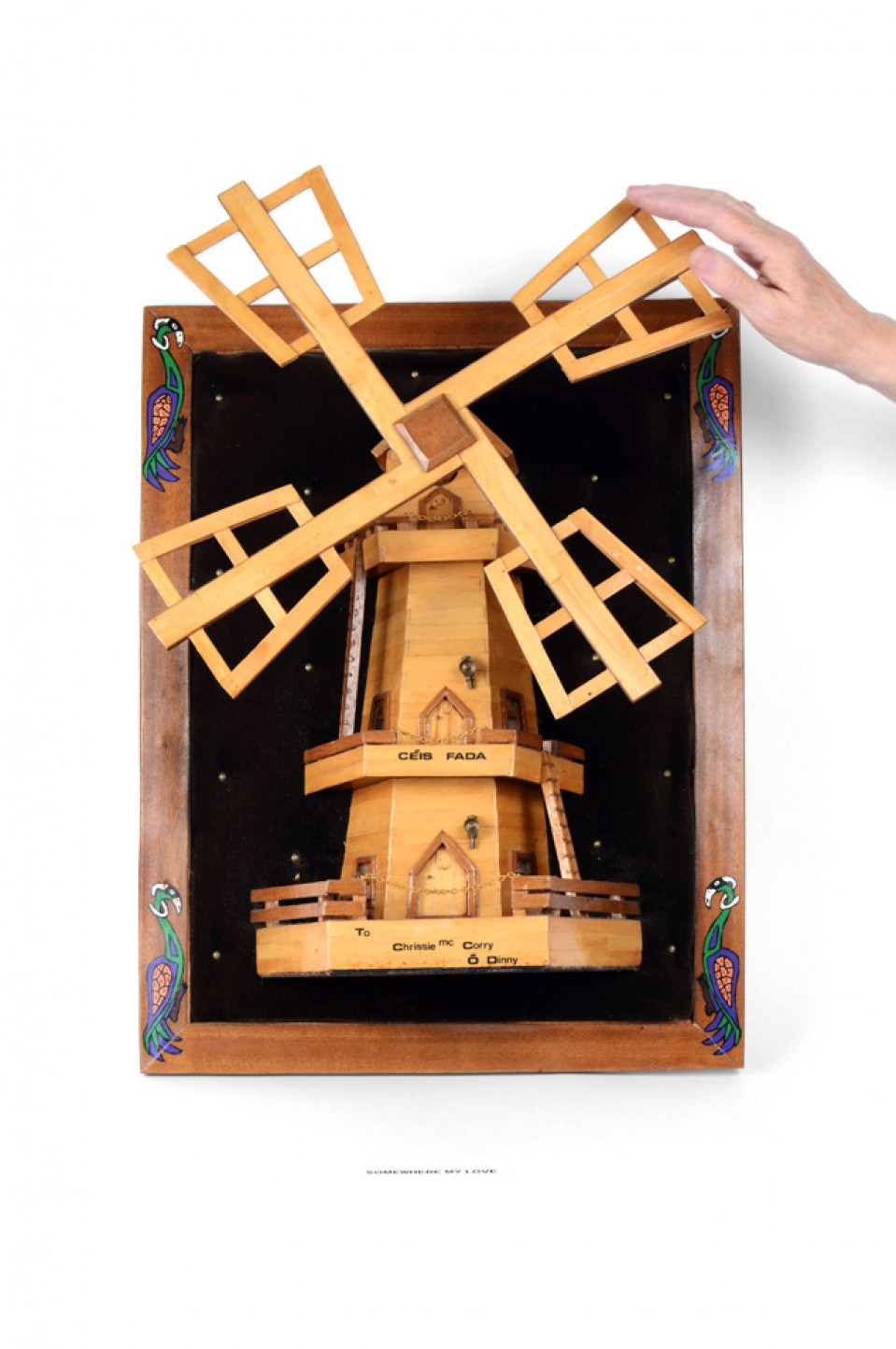
Krenn & O’Beirn, Somewhere my Love, 2018. Photographic print of artefact Dimensions: 50 cm x 30 cm 30cm Testimony and artefact courtesy of Chrisse McCorry, 50+ Group Materials: Music box, Brass chain, brass tacks, lollypop sticks, mahogany, match sticks, paint, timber strips, upholstered velvet & wood. ‘Somewhere my Love’* was the song that plays on it. There’s a name on it ‘To Chrissy McCorry ó Dinny’.** Oh! Dinny, That’s a fella from Derry. I don’t even know his second name. Dinny was my son’s friend who was also in jail. I was given many objects, every time I went on a visit I got something. I keep it in my bedroom. Most nights when I go in I turn it on to listen to the song, as it’s one of my favourite songs.
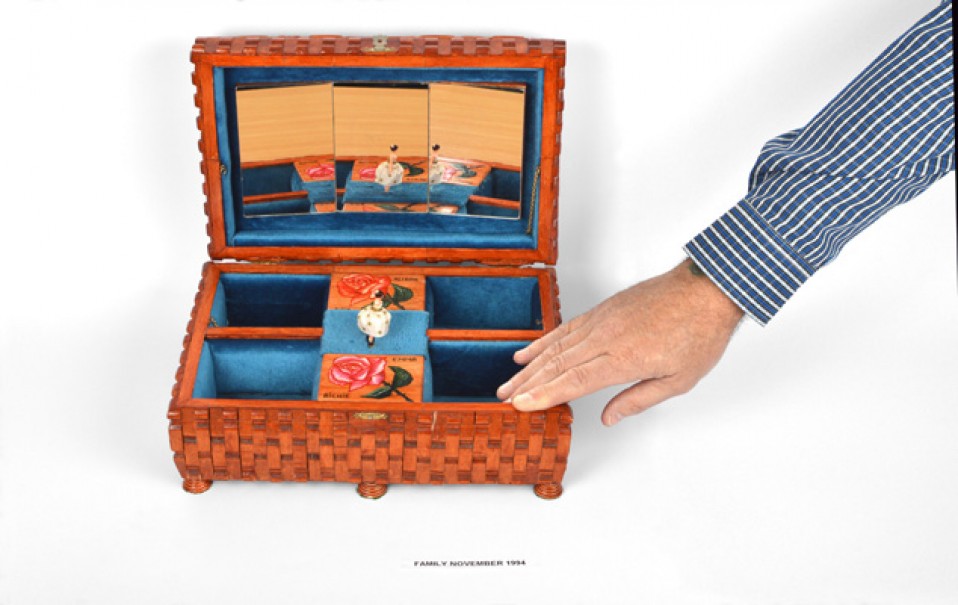
Krenn & O’Beirn, Family Nov 1994, 2018 Photographic print of artefact Materials: Ballerina doll, blue velvet, brass fittings, chess pawns, clothes pegs, mirror, music box mechanism, paint & varnish Artefact dimensions when open: 40 cm x 30 cm x 200cm Testimony and artefact courtesy of loyalist ex-prisoner I was in the Maze in 1989. I was in the Crumlin Road Jail* in 1991. I was released in 1996, so it would have been made between 1992 and 1996. It’s made of clothespegs. The legs are from the bottoms of the pawns in a chess set. It took a long time and effort – many nights spent – but it was enjoyable making it. When the door closed, you were locked up. That’s the bottom line. You had to do something and I was always for doing something with my hands. At that stage, there was no TV so it was either read books or get involved in handicrafts. * Crumlin Rd Jail was a former prison in central Belfast where people were held on remand before being sentenced to Long Kesh or other prisons. It was linked by an underground tunnel to the former courthouse which was directly across the road. The site of the jail has now been developed as a visitor attraction. The former courthouse lies derelict awaiting redevelopment.
About the artists
Martin Krenn and Aisling O’Beirn are
artists who have worked in the field of socially engaged art for many
years. O’ Beirn is based in Belfast and teaches at Ulster University;
Krenn is living in Vienna, teaching at the University of Applied Arts.
Their work is being supported by the archaeologist Laura McAtackney. The
project is part of Traces a three-year project funded in 2016 by the
European Commission as part of the Horizon 2020 Research an Innovation
Programme.
Project participants: Simon Bridge, Phil Holland, David Stitt,
The 50+Group under the umbrella of Tar Anall, The Eileen Hickey Irish
Republican History Museum, The Roddy McCorley Society Museum, Andy Tyrie Interpretive Centre,
as well as a number of contributors who choose to remain anonymous. 6
by the European Commission as part of the Horizon 2020 Research an
Innovation Programme.
For more information about Martin Krenn see
For more information about Aisling O'Beirn see
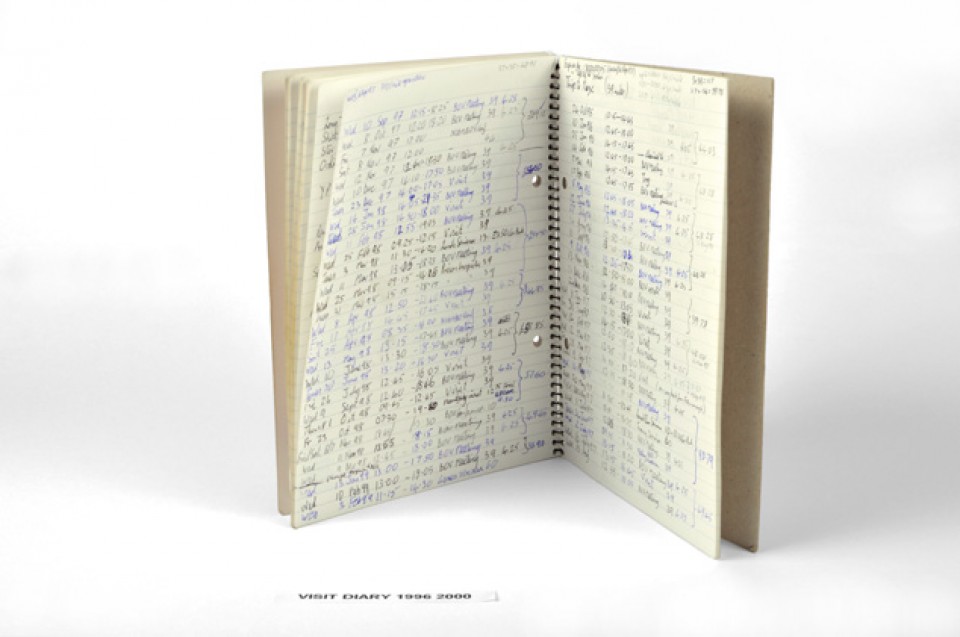
Krenn & O’Beirn, Visit Diary 1996 - 2000, 2018 Photographic print of artefact Dimensions: 50 cm x 30 cm 30cm Testimony and artefact courtesy of Simon Bridge, former member of the Board of Visitors Description: Spiral bound, lined notebook with timed and dated visits to the prison This is my personal log book, which I found useful to record each time I was in the prison; who I’d seen, what we’d done, so I could refer as a reminder for the future. I’ve got brief notes of all the visits that I’d made and then at the back of the book I’d actually put one line for each visit with the exact time, what it was for and the mileage as a basis of which I could then complete the travel claims. Staff never went into the wings, except when they went in bulk to search, whereas in normal prisons staff would have walked up and down the wings when prisoners are shut in their cells. Here they left prisoners to free range the wings. We as visitors walked into the wings but the staff didn’t.
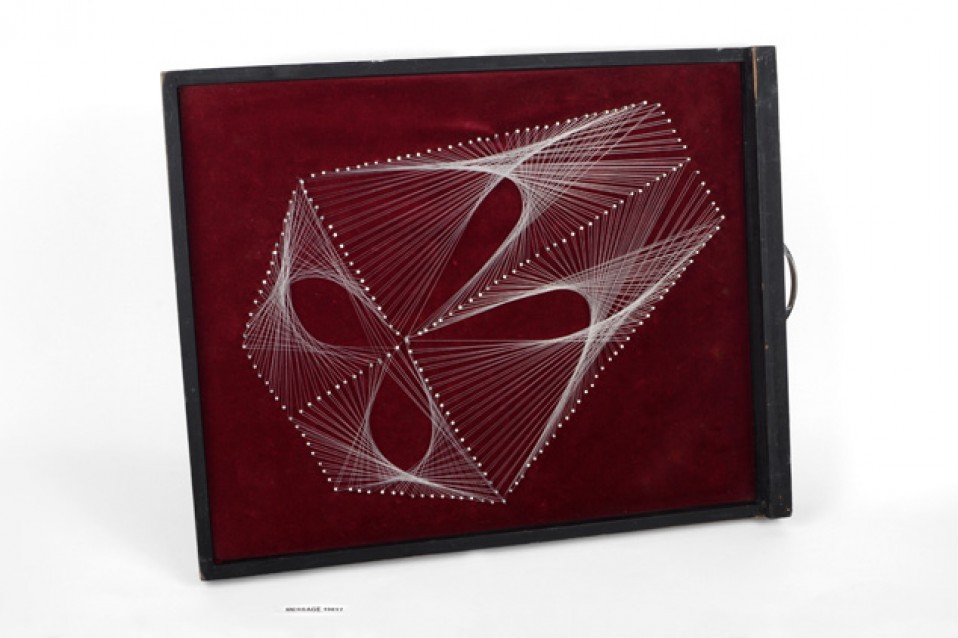
Krenn & O’Beirn, Message 1981?, 2018 Photographic print of artefact Dimensions: 50 cm x 30 cm 30cm Testimony courtesy of loyalist ex-prisoner, object made by Krenn & O’ Beirn in response to testimony Materials: Chalk, found display drawer lined with plum coloured velvet, fishing line, panel pins. Made by Krenn and O’ Beirn in response to loyalist testimony. Many years ago there was a particularly strange scenario.* I remember kites been flown from the prison. It must have been connected to the hunger strikes, but I’m not sure, it might have been before that. The kites were flown so high that they looked just like very small coffins. They cut them and there was about 200 metres of fishing line on each to launch it into the sky. I remember it well because we followed one of the kites for about 2 miles from where we lived. We found the kite and it had messages written on it in Irish. I brought it home. My Mum and Dad both worked and when they walked in that night there was a white coffin just sitting on the floor. It was the kite. I’ve never been able to get an explanation, it was definitely republican prisoners. I’ve heard that it might have been the Official IRA sending messages out. I don’t know whether that’s true or not. It would be interesting to find out what that was all about because it wasn’t just one kite, there was a number of them, made from white bed sheets. * The author of the statement grew up as a child in a housing estate very close to Long Kesh/Maze. Years later, as an adult, he eventually got arrested and became an inmate of this prison. His experience as a prisoner is described in “Reflection”.
Image top:
Krenn & O’Beirn, Big Mid’s Dartboard 2018
Photographic print of artefact
Dimensions: 50 cm x 30 cm 30cm
Testimony courtesy republican contributor, artefact courtesy of The Roddy McCorley Society Museum
Materials: Coloured metallic threads, lollypop sticks, green baize, metal chain, panel pins & plywood
This dartboard* was probably sent out from Long Kesh in end of
1974 or 1975. It says at the bottom ‘From Martin, with respect’. He
would be among the last few internees to be released because he had
such a big name in republican circles. He and certain other people were
let out last, for whatever reason. The British obviously thought that
up.
A guy called ‘Big Mid’ has given the dartboard to us. I said
to the person who brought it in, ‘could you give me an address and ‘Big
Mid’s name so that I can let him know that we’d received it and put it
on show in the museum’. But he did not give me the name and replied
‘just call him Big Mid’. There must have been major security
surrounding ‘Big Mid’. Apparently, this guy is very well-known in
Ardoyne.
* The Andy Tyrie Interpretive Centre also have a dartboard made by a loyalist using the same technique.
--------------------------------------------------------------------------------------------------------------------------------------------------------------
'Dispersed Presence – The Material Culture of Long Kesh/Maze' is an exhibition from the project Transforming Long/Kesh Maze by one the Creative Co-Production of the research project TRACES-Transmitting contentious heritages with the arts. From intervention to Co-Productions, which has received funding from the European Union’s Horizon 2020 research and innovation programme under grant agreement No 693857 www.tracesproject.eu.
Fanzine no. 06, produced by TRACES, has been dedicated to this project and copies are available in PS².
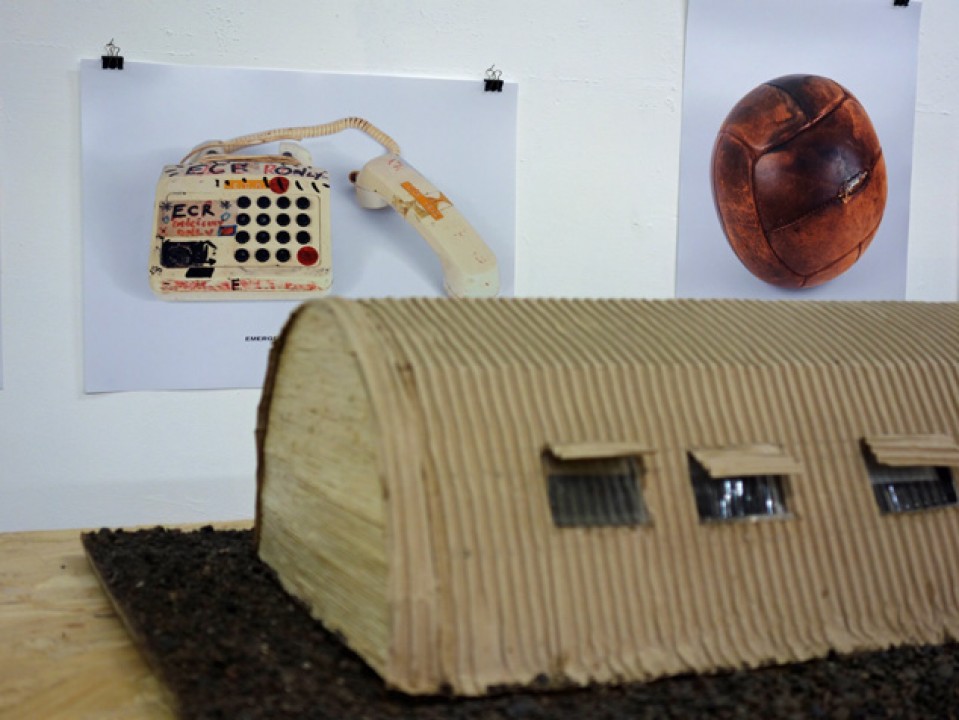
Installation view, PS²


